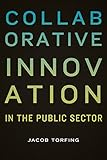Collaborative innovation in the public sector / Jacob Torfing.
Material type: TextSeries: Public management and changePublisher: Washington, DC : Georgetown University Press, 2016Description: ix, 353 pages ; 23 cmContent type:
TextSeries: Public management and changePublisher: Washington, DC : Georgetown University Press, 2016Description: ix, 353 pages ; 23 cmContent type: - text
- unmediated
- volume
- 9781626163607 (pbk.)
- 9781626163591 (hbk.)
- 352.37 TOR 23 011788
| Item type | Current library | Call number | Status | Date due | Barcode |
|---|---|---|---|---|---|
 Book
Book
|
Indian Institute for Human Settlements, Bangalore | 352.37 TOR 011788 (Browse shelf(Opens below)) | Available | 011788 |
Includes bibliographical references (pages 311-339) and index.
Introduction : collaborative innovation in the public sector -- Defining and contextualizing innovation in the public sector -- Collaborative interaction as a source of public innovation -- Towards a theory of collaborative innovation -- Triggering innovation and collaboration -- Mobilizing and empowering actors and institutionalizing interaction -- Enhancing mutual, expansive and transformative learning -- Making and implementing bold and creative decisions -- Diffusing public innovation through collaborative networks -- Enhancing collaborative innovation through leadership and management -- Reforming public governance / enhancing collaborative innovation -- Conclusion: summary propositions about collaborative innovation.
Public sector innovation is important because the pressures of growing expectations from citizens, budget crunches, and a surge of complex governance problems cannot be solved by standard government solutions or increased funding. In order to innovate, government increasingly needs to collaborate with networks of partners across agency boundaries and especially with the nonprofit and private sectors to find new solutions. This interaction within a network can enhance creative and effective governance solutions. In this book, Jacob Torfing closely examines the link between network-based collaborative governance and innovation, proposes a framework for the study of collaborative innovation, and discusses this approach in light of theoretical insights from other disciplines and from examples of public innovation drawn from the United States, Europe, and Australia. This book will move scholars closer to being able to develop a theory of collaborative innovation.


There are no comments on this title.